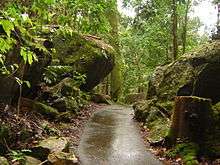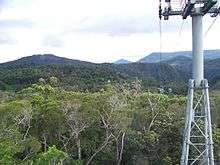Queensland tropical rain forests

The Queensland tropical rain forests are a terrestrial ecoregion located in northeastern Australia and belonging to the Australasian ecozone. The forest contains the world's best living record of the major stages in the evolutionary history of the world’s land plants.[1] The history of the evolution of marsupials and songbirds is also well represented.
The ecoregion covers 32,700 square kilometers (12,600 sq mi) of northeastern coastal Queensland, from the coast up a series of plateaus and tablelands to the mountains behind the coast. The ecoregion comprises three separate sections. The northern area, which includes Cairns, is the largest, from 15°30’ to 19°25’ south latitude. This northern section is also known as the Wet Tropics bioregion.
Flora

The Queensland tropical rain forests are designated one of the Global 200 ecoregions. The ecoregion is the largest remnant of Australia's rain forest flora, home to ancient assemblage of plants, called the Antarctic flora, presently characteristic of New Zealand and southern Chile. Fossil pollen records indicate closed forest covered most of Australia between 50 to 100 million years ago.[2] These forests represent the closest living remnant of the vegetation type from which all of Australia's unique marsupials developed.[2] The vegetation remained across Australia and Antarctica until about 15 million years ago.
Conifers of the southern hemisphere family Araucariaceae are the characteristic tree species. In the northern section of the ecoregion, Kauri commonly form the forest canopy, with Agathis robusta most common at lower elevations, and A. microstachya and A. atropurpurea predominant at higher elevations. In the southern sections, Araucaria cunninghamii is predominant, with Araucaria bidwillii dominant in two small areas. Conifers in the family Podocarpaceae are also present, including genera Podocarpus and Sundacarpus. The forests are thick with vines, ferns, epiphytes, and palms.
These forests are limited to areas of high rainfall and good soils. In waterlogged soils, the rainforest flora gives way to Melaleuca thickets, and on poor soils and in drier areas Eucalyptus becomes dominant. The rainforest flora is intolerant of fire, and where periods of drought have allowed devastating fires, the rainforest flora has retreated, allowing fire-tolerant Eucalyptus to become established. If a relatively wet period persists, the rainforest flora may reestablish itself. It is thought that the land management practices of the aboriginal Australians, which involve setting regular fires to keep the eucalyptus woodlands open, may have encouraged the expansion of eucalyptus forests at the expense of the rainforest flora. These rainforests seem to have retreated considerably since the arrival of the aboriginals' ancestors 50,000 years ago, and are presently limited to isolated pockets comprising less than 2% of the continent's area.
Conservation
These forests are particularly interesting because of their southern location and the high degree of endemism of their plant and animal species. Deforestation caused by logging, road building and farming has led to habitat fragmentation [3] and diminishing populations of species such as spotted-tailed quoll (Dasyurus maculatus), cassowary (Casuarius casuarius), and ring-tail possum (Hemibelideus lemuroides). Introduced species also pose a serious threat to many native species.
In an effort to preserve the Daintree Rainforest north of the Daintree River it was decided by the Government of Queensland in 1993 to halt the spread of the electricity network north of that point, providing a limit to tourist development.[4]
Protected areas include the following:
Tourism

The forests, together with the Great Barrier Reef, have been identified and promoted as a major tourist attraction of Tropical North Queensland, one of five within the state.[5] One of the most significant tourist attractions in the rain forests is the Skyrail Rainforest Cableway.
See also
References
- ↑ "Queensland tropical rain forests". Terrestrial Ecoregions. World Wildlife Fund. Retrieved 2 December 2012.
- 1 2 McDonald, Geoff; Marcus B. Lane (2000). Securing the Wet Tropics?: A Retrospective on Managing Australia's Tropical Rainforests. Federation Press. p. 14. ISBN 1862873496. Retrieved 3 December 2012.
- ↑ Champion, Neil (2006). Tropical Rain Forests. Black Rabbit Books. p. 18. ISBN 1583405089. Retrieved 2 December 2012.
- ↑ Sharma, K. (2004). Tourism & Economic Development. Sarup & Sons. p. 330. ISBN 8176254967. Retrieved 2 December 2012.
- ↑ Sharma, K. K. (2004). World Tourism Today. Sarup & Sons. p. 172. ISBN 8176255122. Retrieved 2 December 2012.
External links
- "Queensland tropical rain forests". Terrestrial Ecoregions. World Wildlife Fund.